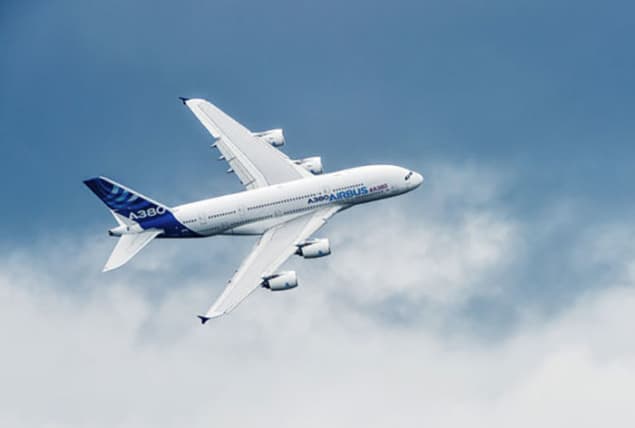
Rerouting transatlantic flights to follow the most climate-friendly path could damage the climate 10% less for an increase in costs of just 1%. That’s according to a team from Germany, the Netherlands, Belgium, Norway and the UK.
“An attractive aspect of our approach is that it potentially enables some mitigation of aviation’s climate impact…using the current aircraft fleet,” Volker Grewe of the Deutsches Zentrum für Luft- und Raumfahrt, Germany, and Delft University of Technology in the Netherlands, explains. “Some mitigation options involve changes in aircraft or engine design, which would take decades to implement given the slow – and expensive – turnover of the global fleet.”
Volker and colleagues modelled routings for 800 daily flights across the Atlantic under five typical winter weather patterns and three typical summer patterns. The team combined the EMAC chemistry-climate model with an air-traffic simulator, choosing 85 variations for each flight path – 17 horizontal and five vertical. Then they picked the most “eco-efficient”, which is the path with the best ratio of climate-impact reduction to cost increase.
Multiple impacts
Aircraft have an impact on the climate by emitting carbon dioxide, water vapour, nitrogen oxide and particulates. These alter the concentration of the greenhouse gases ozone and methane, and also form contrails. Where and how high the plane is, as well as the time of day and season, all alter the size of its climate effect.
“It is now well established that – unlike the climate effects of CO2 – the non-CO2 climate effects such as contrail formation depend sensitively on when and where the aircraft emissions occur,” says Grewe, “and these sensitive regions vary in location and importance from day to day, as they are strongly influenced by the prevailing weather patterns.”
Contrails, for example, form if the hot, moist exhaust from the jet engine becomes saturated with respect to water when it mixes with the air in the atmosphere. And the trails only persist if the ambient air is saturated with respect to ice. Contrails affect both incoming radiation from the Sun and the exit to space of infrared radiation emitted by Earth and its atmosphere. On average, the trails cause warming, but close to sunrise and sunset they can result in cooling.
Ozone and methane
In general, aircraft emissions tend to boost the amount of ozone and decrease methane concentrations, with the warming from the extra ozone outweighing the cooling from the reduction in methane. But this varies a lot locally, and in some regions the emitted nitrogen oxides cause cooling.
“Put simply, if we can avoid those regions in the atmosphere where the non-CO2 emissions have the largest climate effect, we can reduce the climate impact significantly,” says Grewe. “Our modelling study showed that a large reduction of aviation’s climate impact is feasible at relatively low costs.”
Rerouting flights could cut their climate harm but may increase fuel and staff costs. Cost-efficient reductions in climate impact mostly resulted from avoiding the formation of warming contrails or from producing cooling contrails, Grewe and his colleagues found.
Close collaboration
Investigating such mitigation options requires close collaboration between atmospheric scientists and disciplines like air-traffic management, Grewe says. He believes all sectors must play a role in meeting the internationally agreed 2 °C target for the total climate effect of human activity.
“This is particularly challenging for the aviation sector, given the predictions of its continued growth over coming decades,” he says. “Hence, we need a combination of various mitigation options – technological, such as cleaner and more efficient engines, and operational, i.e. more eco-efficient routes. To make this happen, a political framework is required, which aims at limiting aviation impacts. It might be on an international or regional basis.”
Airlines would in all likelihood need regulations or a market incentive such as a price on climate impact to carry out such climate-friendly routing. While the International Civil Aviation Organisation (ICAO) has decided to implement the Carbon Offsetting and Reduction Scheme for International Aviation (CORSIA), non-carbon-dioxide effects are still not considered in political decisions to limit the climate effect of aviation, Grewe says.
Reliable forecasts
“Implementing our proposed approach…is likely to be at least 5–10 years in the future – it should be considered ‘exploratory’ at present,” he adds. “We have to convince all stakeholders that the approach is worthwhile and feasible in practice, and that the costs associated with it are proportionate. And because the location of the climate-sensitive regions varies markedly from day to day, we also need to clearly establish that we can reliably forecast these areas sufficiently far in advance, so that re-routing aircraft to avoid them can be done with confidence.”
Now the scientists, who included a road map in their paper in Environmental Research Letters (ERL), are looking for more funding. They are also participating in ATM4E, a European project investigating whether it’s possible to avoid climate-sensitive regions in areas with high traffic density, as well as how the approach can be made operational, included in a weather forecast system, and verified.
- A version of this article first appeared on environmentalresearchweb



